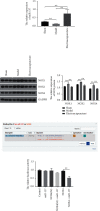Electroacupuncture Attenuates Cognitive Impairment in Rat Model of Chronic Cerebral Hypoperfusion via miR-137/NOX4 Axis
- PMID: 33986822
- PMCID: PMC8079190
- DOI: 10.1155/2021/8842022
Electroacupuncture Attenuates Cognitive Impairment in Rat Model of Chronic Cerebral Hypoperfusion via miR-137/NOX4 Axis
Abstract
Electroacupuncture has shown protective effects on cognitive decline. However, the underlying molecular mechanisms are not clear. The present study was conducted to determine whether the cognitive function was ameliorated in cerebral hypoperfusion rats following electroacupuncture and to investigate the role of miR-137/NOX4 axis. In this study, chronic cerebral hypoperfusion (CCH) model was established by bilateral common carotid artery occlusion. Electroacupuncture treatment attenuated brain injury in CCH model group via regulating miR-137/NOX4 axis. Furthermore, the data of neuronal apoptosis and oxidative stress were observed. Our findings indicated that (1) neuronal apoptosis and oxidative stress in CCH rats were significantly increased compared with control group; (2) the animal cognitive performance was evaluated using the Morris water maze (MWM). The results showed that electroacupuncture therapy ameliorated spatial learning and memory impairment in cerebral hypoperfusion rats; and (3) electroacupuncture therapy reduces neuronal apoptosis and oxidative stress by activating miR-137/NOX4 axis. These results suggest that electroacupuncture therapy for CCH may be mediated by miR-137/NOX4 axis. Electroacupuncture therapy may act as a potential therapeutic approach for chronic cerebral hypoperfusion.
Copyright © 2021 Xiaochen Bi et al.
Conflict of interest statement
The authors declare that there are no conflicts of interest in the publication of this manuscript.
Figures





Similar articles
-
Neuregulin1 attenuates cognitive deficits and hippocampal CA1 neuronal apoptosis partly via ErbB4 receptor in a rat model of chronic cerebral hypoperfusion.Behav Brain Res. 2019 Jun 3;365:141-149. doi: 10.1016/j.bbr.2019.02.046. Epub 2019 Feb 28. Behav Brain Res. 2019. PMID: 30826297
-
miR-132 Down-regulates Methyl CpG Binding Protein 2 (MeCP2) During Cognitive Dysfunction Following Chronic Cerebral Hypoperfusion.Curr Neurovasc Res. 2017;14(4):385-396. doi: 10.2174/1567202614666171101115308. Curr Neurovasc Res. 2017. PMID: 29090669
-
Inhibition of MicroRNA-96 Ameliorates Cognitive Impairment and Inactivation Autophagy Following Chronic Cerebral Hypoperfusion in the Rat.Cell Physiol Biochem. 2018;49(1):78-86. doi: 10.1159/000492844. Epub 2018 Aug 22. Cell Physiol Biochem. 2018. PMID: 30134226
-
Molecular Mechanisms of Vascular Dementia: What Can Be Learned from Animal Models of Chronic Cerebral Hypoperfusion?Mol Neurobiol. 2017 Jul;54(5):3670-3682. doi: 10.1007/s12035-016-9915-1. Epub 2016 May 20. Mol Neurobiol. 2017. PMID: 27206432 Review.
-
Insights of Chinese herbal medicine for mitochondrial dysfunction in chronic cerebral hypoperfusion induced cognitive impairment: Existed evidences and potential directions.Front Pharmacol. 2023 Feb 10;14:1138566. doi: 10.3389/fphar.2023.1138566. eCollection 2023. Front Pharmacol. 2023. PMID: 36843941 Free PMC article. Review.
Cited by
-
Electroacupuncture of the Baihui and Shenting acupoints for vascular dementia in rats through the miR-81/IL-16/PSD-95 pathway.Ann Transl Med. 2022 May;10(10):540. doi: 10.21037/atm-22-2068. Ann Transl Med. 2022. PMID: 35722406 Free PMC article.
-
Protective Role of Electroacupuncture Against Cognitive Impairment in Neurological Diseases.Curr Neuropharmacol. 2025;23(2):145-171. doi: 10.2174/1570159X22999240209102116. Curr Neuropharmacol. 2025. PMID: 38379403 Free PMC article. Review.
-
Visualization and Analysis of the Mapping Knowledge Domain of Acupuncture and Central Nervous System Cell Apoptosis.Evid Based Complement Alternat Med. 2022 Apr 14;2022:1751702. doi: 10.1155/2022/1751702. eCollection 2022. Evid Based Complement Alternat Med. 2022. PMID: 35463084 Free PMC article. Review.
References
-
- Cechetti F., Worm P. V., Pereira L. O., Siqueira I. R., Netto A. C. The modified 2VO ischemia protocol causes cognitive impairment similar to that induced by the standard method, but with a better survival rate. Brazilian Journal of Medical and Biological Research. 2010;43(12):1178–1183. doi: 10.1590/s0100-879x2010007500124. - DOI - PubMed
LinkOut - more resources
Full Text Sources
Other Literature Sources

